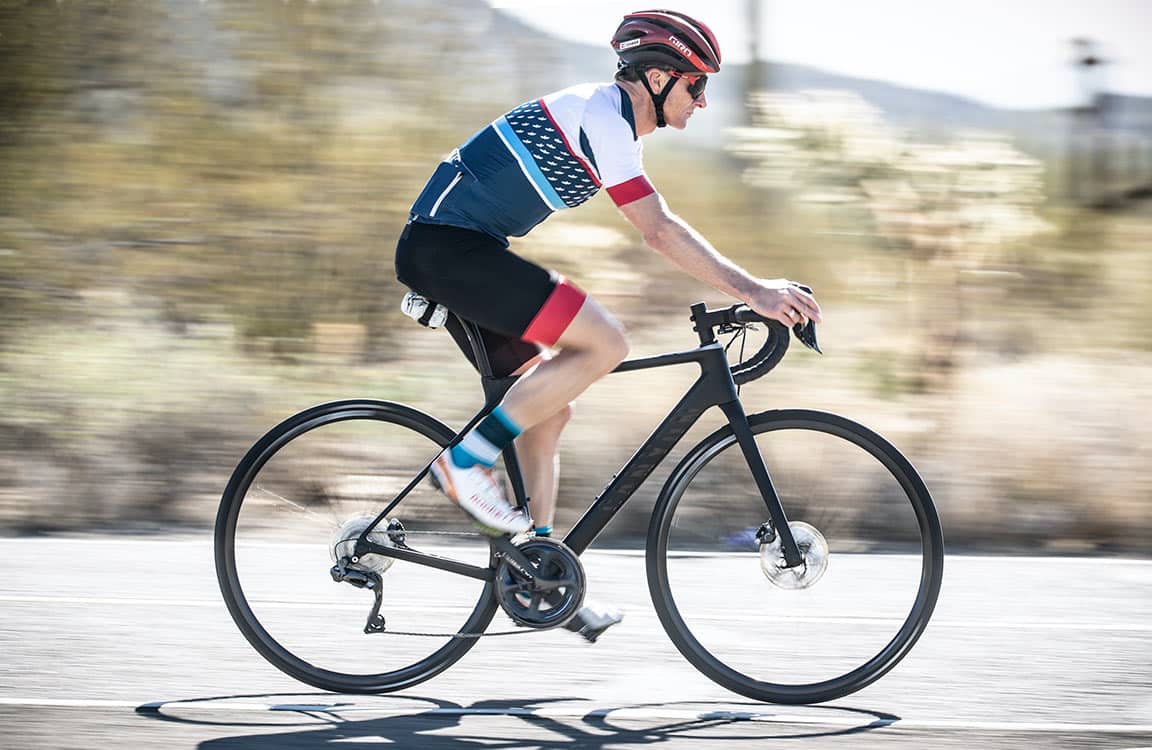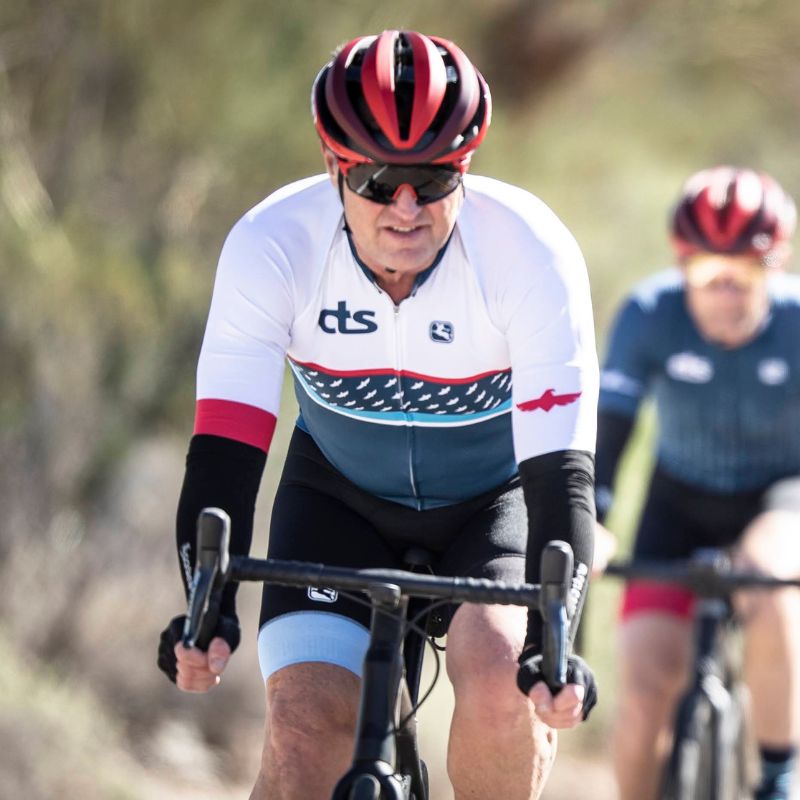
Cycling Training for Climbs When You Don’t Have Hills
By Chris Carmichael,
Founder and Head Coach of CTS
Many of the most popular events and iconic cycling destinations feature a lot of climbing, whether it comes in the form of mountain passes, endless rollers, or punchy power hills. If you live in an area with easy access to short and long climbs, you’re in luck because you can train on event-specific terrain. Cyclists who live in flat areas can still perform well in mountains or hilly terrain, they just have to be more creative in training. Here’s how to get it done.
Find or Create More Resistance
Going uphill, gravity is always robbing you of momentum. As your pedal stroke reaches less productive zones with your feet at the top and bottom, the bike slows more than it would during this same fluctuation in power output on flat ground. And the steeper the climb, the greater the challenge of maintaining momentum. If you don’t have gravity to fight against, you need to find another source of resistance. Although they are not perfect analogs to climbing, riding into a headwind or riding on gravel (or both) can at least replicate the momentum-robbing effect of climbing uphill.
Of course, with the advances in indoor cycling over the past several years, you can also replicate the realistic resistance of almost any type of hill or mountain with a smart trainer or smart bike and apps like Zwift. Depending on the app you use, riders who can obtain .gpx files of the course for their goal event can also simulate the exact undulations of the climbs or entire course with a smart trainer.
Ride steady, uninterrupted intervals
Particularly when training on flat ground for events with prolonged climbs (15-60 minutes), it’s important to realize your legs will be under tension almost the entire time. Long Tempo, Sweetspot, and Lactate Threshold intervals are key workouts for developing the aerobic conditioning and sustainable power for long climbs. One of the benefits of riding into a headwind or on a softer surface is that the increased resistance typically results in a lower cadence (70-85rpm) and higher force per pedal stroke. This requires recruiting more muscle fibers, including contributions from an adaptable portion of your glycolytic fast-twitch fibers. Whether you’re riding against increased rolling resistance, wind resistance, or electromagnetic resistance, you also want to maintain a steady and unrelenting effort (not necessarily at a high intensity, just uninterrupted) because climbing isn’t just about power output. It’s also about how you use your muscles to produce that power, in that environment, when you’re 45 minutes into the climb.
Strengthen shoulders and triceps
Cyclists who live in very flat areas don’t have much reason to ride out of the saddle for more than a few seconds at a time. Most of your out-of-the-saddle time is from quick accelerations, starts from stop signs, or city limit sprints. It may sound silly to suggest that specific training is needed to prepare for the upper body demands of climbing out of the saddle… until you’re on a long climb and you realize that when you stand repeatedly your triceps burn out before your legs do. Weakness in the arms and shoulders is even more limiting during long climbs on gravel because the rough, unstable surface increases upper body fatigue on climbs, descents, and flat ground. I recommend standard pushups and close grip pushups (a pushup with your hands under your shoulders and your elbows by your sides), overhead presses with dumbbells or resistance bands, tricep dips, and incline bench presses.
Feel Stronger in 6 Weeks — No Matter Your Age
Climbs feel steeper? Recovery slower?
You’re not done getting faster — you just need a smarter plan.
The 6-Week Masters Power Build Coaching Program is designed for cyclists 50+ who want to boost power, recover faster, and ride stronger — all with expert 1:1 coaching.
- Personalized 6-Week Training Plan
- 1:1 Coaching + TrainingPeaks Premium
- Mobility & Strength Bonus Guides
💪 Guarantee: Stronger or free.
Start your 6-week journey for $149Get as fit as possible
While this is a universal goal for cyclists, I mention it here to make the point that your fundamental fitness will be your best weapon for climbing, even if it was developed on flat ground. The strategies above will help, but your top priorities should still be maximizing aerobic endurance and sustainable power at lactate threshold, and raising your power at lactate threshold to be a higher percentage of power at VO2max. Everyone struggles on steep hills and long mountain passes, and greater fitness always gives you more tools and options for dealing with adversity.
► Free Cycling Training Assessment Quiz
Take our free 2-minute quiz to discover how effective your training is and get recommendations for how you can improve.
Notice, I didn’t mention weight loss in the strategies above, either. Yes, being lighter can increase your power-to-weight ratio, but for many athletes changes in bodyweight occur as a byproduct of structured training and eating to support that training. I prefer to lead with fitness and nutrition and let bodyweight follow, and then only proactively pursue weight loss once some fitness gains have been realized and only if it makes sense for the athlete and his or her performance goals. Work on the ‘power’ side of the power-to-weight ratio first.
Living in the mountains is nice, but cyclists who live in flat places can go uphill just fine. I grew up in South Florida, and though I never became a pure climber I developed the speed and strength to hold my own in hilly road races (I even won the Morgul-Bismark stage of the Coors Classic on “The Wall”), on the steep bergs in Belgium, and the big passes in the Alps and Dolomites. It can be done, and with a little creativity and perseverance, you can do it, too.
► FREE Mini-Course: Learn How to Maximize Your Limited Training Time
Learn step-by-step how to overcome limited training time and get faster. Walk away with a personalized plan to increase your performance.
"*" indicates required fields


Comments 4
Hi Chris,
Thanks again for one of your great articles. I love to read and still learn from them, as a cycling coach myself. For me living in The Netherlands, I can always make a trip to the south of our country to find lots of short hills on a small space. And perform sessisons more often on the same hill, over and over.
This gives me the oppertunity to try several climbing and resistance techniques. And ofcourse we do have a lot of wind, nearby the coast, were I live.
Great stuff!
Training to climb while living in the flatlands is obviously possible. Can skill training to descend be done in the flatlands? “What goes up, must come down!”
Good article, thank you!